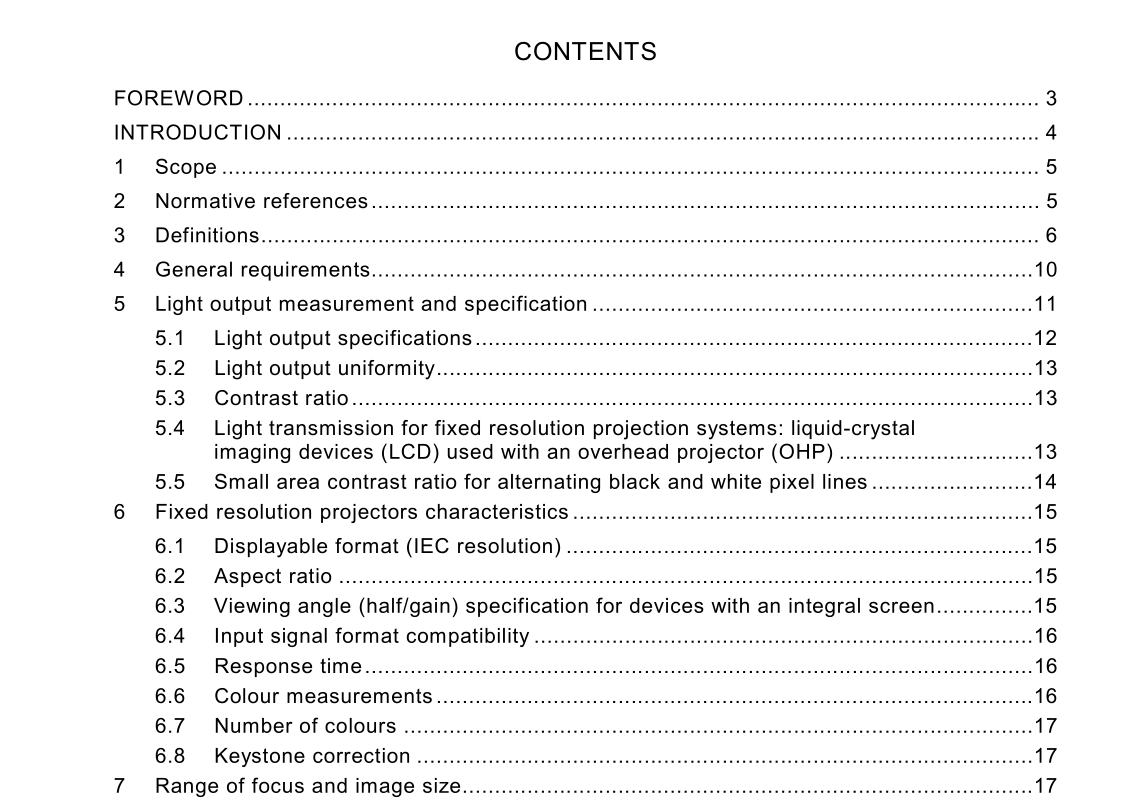IEC 61947-1 pdf download

IEC 61947-1 pdf download.Electronic projection – Measurement and documentation of key performance criteria
3 Definitions
For the purposes of this standard, the following definitions apply. 3.1 active matrix display display that uses switches at each pixel to select those pixels to which a voltage will be applied 3.2 active viewing area horizontal and vertical dimensions in millimetres (inches) of the boundary of the array of pixels. It may also be expressed in square millimetres or square inches 3.3 aperture ratio (fill factor) light transmitting/reflecting area of a pixel times the number of pixels divided by the active viewing area (light transmitting area and light blocking area) 3.4 aspect ratio proportions of a projected picture area, for example, the width compared to the height NOTE It is usually expressed in standard ratios such as 4:3, 16:9, or others. 3.5 blanking process of the beam turning off (blanking) which occurs during horizontal and vertical retrace (flyback) 3.6 CIE Commission Internationale de l’Eclairage, the international commission on illumination NOTE The CIE is an organization devoted to international cooperation and exchange of information among its member countries on all matters relating to the art and science of lighting. 3.7 CIE chromaticity values Cartesian coordinates used to define a colour in CIE colour space NOTE The 1931 chromaticity values are designated x and y. In 1976, the CIE defined a more uniform colour space. The 1976 CIE chromaticity values are u′ and v′. 3.8 colour mapping means for accurately displaying colour signals or altering sets of colour signals in a controlled manner 3.9 contrast ratio luminance or illuminance ratio of a light area of the image to the dark area of the same image 3.10 correlated colour temperature (CCT) of the white-point temperature, in kelvins, of the black-body radiator the chromaticity of which is closest to the chromaticity of a particular light, for example, from a display screen, as measured in the 1960 CIE (u, v) uniform chromaticity space 3.11 digital micromirror device (DMD) semiconductor light micromirror array. The DMD can switch incident light on or off in discrete pixels within microseconds to produce projection display systems 3.12 optical distortion situation in which an image is not a true-to-scale reproduction of an object due to the optics of the system NOTE There are many types of distortion, such as anamorphic, barrel, curvilinear, geometric, keystone, panoramic, perspective, radial, stereoscopic, tangential, and wide-angle. 3.13 f/number stop number the reciprocal value of the relative aperture NOTE Relative aperture of a photographic lens: twice the numerical aperture where the numerical aperture is the sine of the semi-angle subtended by the exit pupil at the focal plane. For photographic applications, the aperture is equivalent (within a 1/3 stop) to the ratio of the diameter of the entrance pupil to the focal length. (See ISO 517: 1996(E) Photography – Apertures and related properties pertaining to photographic lenses – Designations and measurements.) 3.14 fall time time, in milliseconds, for the image brightness to change from 90 % of its maximum value to 10 % of its maximum value 3.15 focal length distance between the centre of the focusing lens or mirror and the focal spot. NOTE Shorter focal length projection lenses produce larger screen images for a given distance from the screen 3.16 focus adjustment of an optical system to achieve the greatest possible sharpness 3.17 four corners centres of the four corner points (see Figure A.2), located at 10 % of the distance from the corners to the centre of point 5 3.18 front screen projection image projected on the audience side of a light-reflecting screen3.19 illuminance quotient of a luminous flux incident on an element of the surface containing the point by the area of that element Unit: lux (lx) 3.20 light source life expectancy time that the light source can keep its projected light output as measured in this standard, higher than 50 % of the initial value when tested with a duty cycle of 2 h on and 15 min off 3.21 liquid-crystal display (LCD) display made of material the reflectance or transmittance of which changes when an electric field is applied









